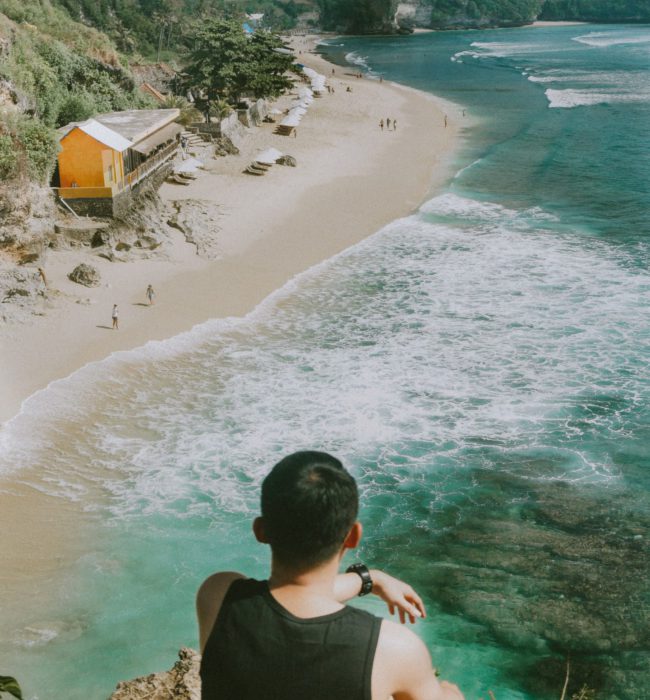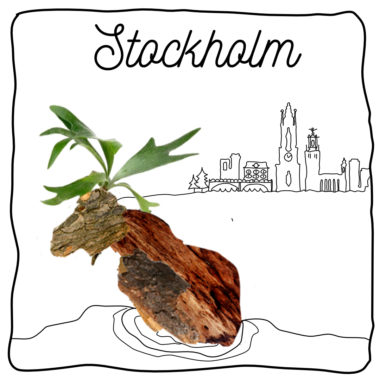Friendly disclaimer! We want to be as accurate as possible, but given these challenging times, we urge you to recheck that the venues are open when you decide to travel.
Bali, a relatively small island, stands unique among the 17,000 others in the Indonesian archipelago. A favourite among tourists for decades, it is a major draw for its amazing natural diversity. Volcanoes, mountains, beaches, reefs, canyons, sacred rivers and rice fields are just a few examples. And so, we’ve rounded up a list of our favourite spots that capture some of Bali’s most stunning views – from the popular to the lesser-known.
On top of the world at Jemeluk viewpoint
Jemeluk is a bay area in Amed village, East Bali, with a beautiful spread of black sand, serene waters, coral reefs and rich marine life. The Jemeluk viewpoint is located higher up towards the southern hillsides. From here, focus northwards to marvel at the sweep of the bay during sunset, the beach and the curving coast, dotted with Jukung boats, yachts, and liveaboards. The mighty Mount Agung, Bali’s highest peak, also looms in the background. If you look closely, the diminished outlines of the volcanic Mt. Batur that erupted several millennia ago. are also visible further north. If you would like a more private experience, arrive earlier for the sunrise view, when the sun isn’t as harsh.
One can grab a quick lunch at one of the many small restaurants in Amed.. Rent a motorbike to further explore the villages of East Bali.
Getting there: The journey to Amed takes 3 hours from Canguu and 2.5 hours from Ubud. It’s best to rent a scooter (costing 60,000 IDR per day). Otherwise, the Grab Taxi is also a good option. Go slow when nearing the area as one can easily miss the turning to the beach. Parking and entrance are free.
Unravelog tip: If you plan to go snorkelling at any of the beaches, the dry season from April to September is the best time, though July and August are the peak period when tourist crowds are at the maximum.
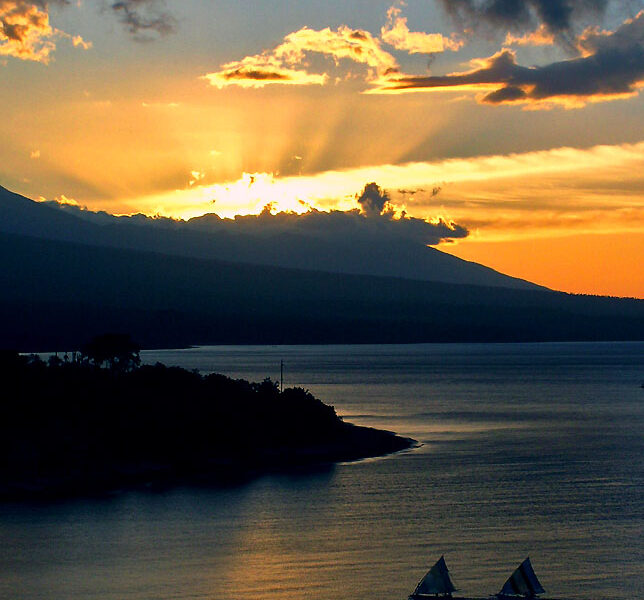
The temple on the sea – Pura Tanah Lot
Bali is called ‘The Land of the Gods’ for its innumerable temples, shrines and deities steeped in a culture of mythology and spirituality. Yet, Tanah Lot (located in Tabanan, about 20 kms north-west of the capital, Denpasar) stands out as one of the most popular and photographed tourist spots – it’s among Bali’s 7 holy oceanic temples, in a unique location atop an offshore rock formation.
In Balinese, Tanah Lot literally means Land [in the] Sea and is actually composed of a set of three temples, with the main one submerged during high tide. Legend has it that a travelling Shaivite monk named Dang Hyan Nirartha, stayed at this rock formation on Bali’s south coast for a night. Realizing its sacredness, he named it Gili Beo, or ‘island of rocks resembling a bird’, and built a temple with local fishermen’s help. Dewa Baruna, or the sea god is the main deity here who’s protected by a giant snake. Locals believe that there are snakes at the foot of the island that ward off evil.
If you plan to enter the temple campus, visit during low tide when the causeway leading up to it isn’t submerged. It is open from 7 am to 7 pm, and gets crowded from 10 am onwards. There is also a dedicated sunset terrace on the north side which also has many shops and eateries. If you want to just witness the sun setting behind the temple, there is a footpath to a raised cliff area to its south, from where this view is exceptional.
Getting there: The best way to reach here is by renting a scooter or taxi, though this is also included as a part of most island-tour packages. The journey takes around 45 minutes from Kuta, Legian, or Seminyak and 30 to 40 minutes from Ubud.
When coming from Denpasar on the main highway towards Kediri town, there is a large sign asking visitors to turn southwest for Pura Tanah Lot. Once parked, you have to walk along pathways dotted with souvenir stalls, before arriving at the sea. The entrance fee is IDR 60,000 for (adult) foreigners. You are expected to wrap sarongs for modesty.
Unravelog tip: A 15-minute walk away from the temple is the lesser-known Melasti beach that also features a waterfall. This is an amazing spot for sunset views where one gets to see the water pouring back into the sea framed by the colours of the setting sun.
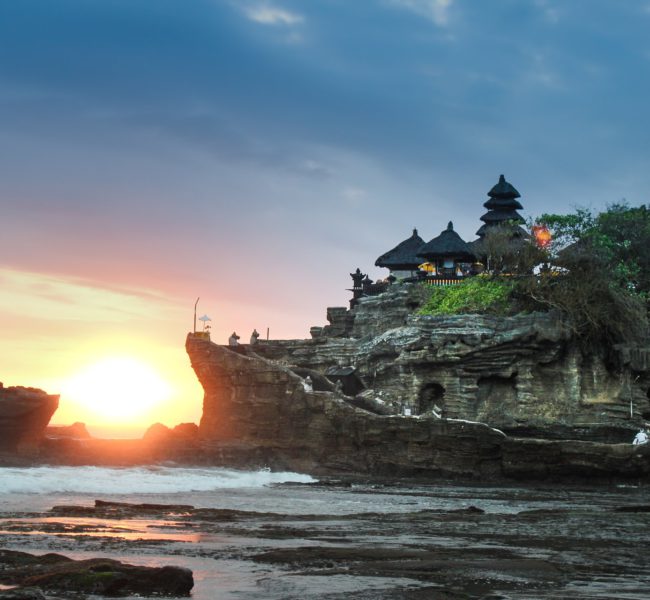
Enter the ‘Gates of Heaven’, at Lempuyang Temple
One spot that will leave any traveller to Bali absolutely stunned is the Pura Penataran Lempuyang Temple. It is located on the slopes of Mount Lempuyang in East Bali, quite close to Amed village (of Jemeluk viewpoint fame). It is considered Bali’s oldest Hindu temple and known as one of the ‘Sad Kahyangan Jagad (six sanctuaries of the world)’ or six holiest temples of Bali.
The temple compound is divided into three: the outer, middle and inner sanctum. A ‘candi bentar’ (split gateway) welcomes you to the outermost sanctum. This structure is what has popularly come to be known to the western world as the ‘Gates of Heaven’. The incredible view whilst standing here includes mighty mountains (Mt. Agung peak), lush forests and the white clouds that truly make you feel you are at heaven’s edge. Reaching here isn’t easy, since the temple stands at 1200 m above sea level and there are around 1500 steps to climb through the forest. There is no formal entrance fee though small donations are accepted. A sarong covering the knees, is the appropriate dress code here.
Getting there: It is located 30 minutes away from the Amed coast and can be included on a day trip to Jemluk bay. From Ubud or Canggu or Densapar, it is a 2+ hour drive and can be reached by scooter or taxi ( via Jl. Prof. Dr. Ida Bagus Mantra on the highway).
Unravelog tip: Due to many visitors at the gate during sunset, one has to line up for photographs. To avoid these crowds, you can also opt to reach early morning and in time for sunrise.
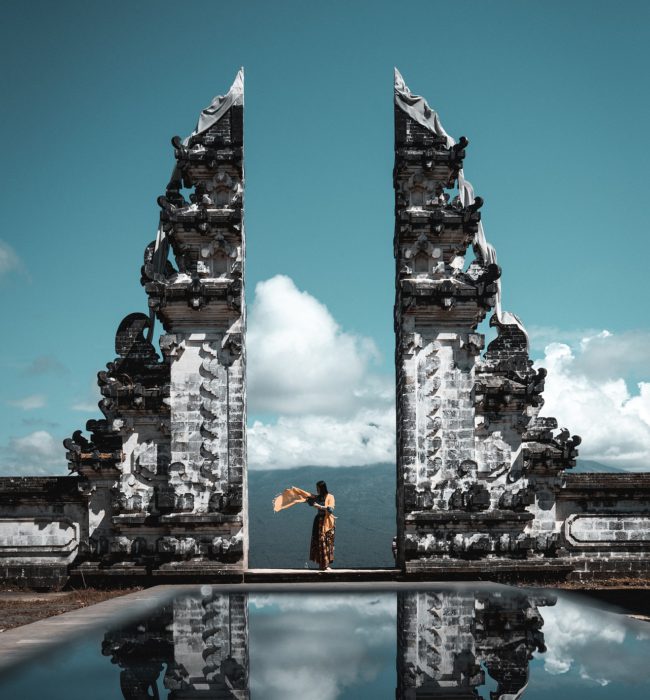
Lushest greens at Jatiluwih rice terraces
The highlands of Bali are covered with thousands of acres of terraced rice fields that extend from the upper volcano regions to the valleys deep below. Among them, the Jatiluwih rice terraces are one of the best examples of Bali’s wealth of natural resources. Blessed with more than 150 rivers and streams, its evergreen fields are able to harvest rice three times a year. Located 700 m above sea level in Tabanan regency of west-central Bali, Jatiliwih seemingly blends in with the flowing topography of Batukaru mountain range.
Jatiluwih literally means beautiful in Balinese – Jati ( ‘real’) and Luwih ( ‘beautiful’). The terraces are maintained by a traditional irrigation management system dating back to the 9th century, run by village cooperatives known as ‘Subak’. You can enjoy the views while dining at any of the small restaurants on the small road overlooking the Jatiluwih rice terraces. Treat yourself to a bonus and catch a great sunset here!. This is a much quieter part of Bali, where you can enjoy the sight of magical fireflies and the sounds of nature.
When planning your visit here, try and include the Alas Kedaton Monkey Forest and the Batukaru Temple nearby in your day’s itinerary – both worth a visit.
Getting there: As it is located in Central Bali, Jatiluwihcan be reached in an hour and a half from Ubud or Canguu by car or scooter. A good driver charges around 600,000 IDR, while it is 300,000 for renting a car. The entrance fee is 40,000 IDR per person, including parking.
Unravelog Tip: To get the most out of rural Bali, make it a two-day trip here. Go hiking through rice terraces, traverse rivers, and pack in a picnic lunch.
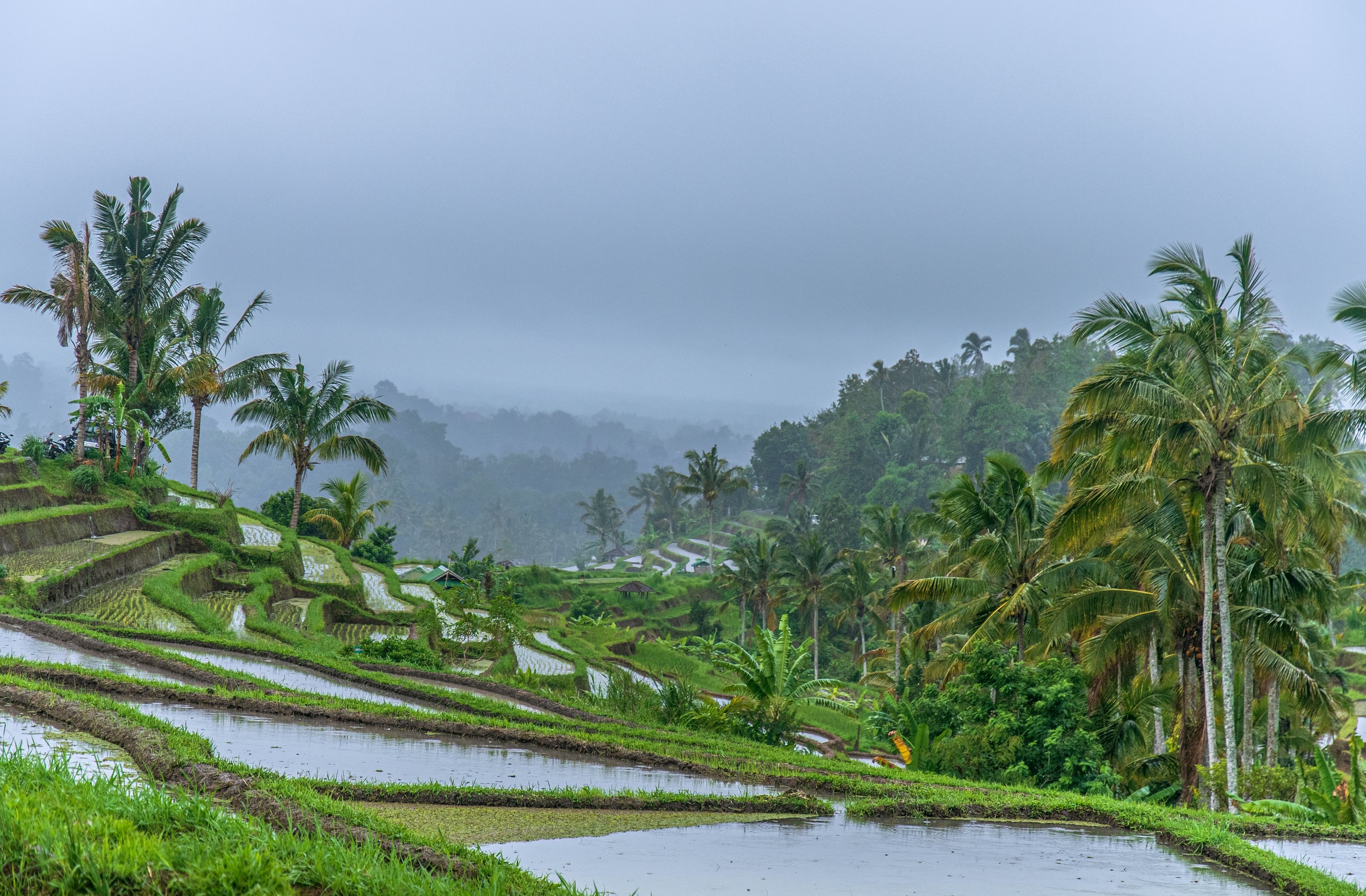
Stand atop a volcano at Mt. Batur
Mount Batur or Kintamani is one of the last active volcanoes of Bali. Located in the island’s northeast, it is centred amidst two concentric calderas (large hollow above the magma chamber of a volcano) 1500m above sea level. The area comprises the ancient villages of Penelokan, Batur, Kintamani (on the edge of the caldera), Bungkah, Toya (on the edge of lake Batur), Kedisan, Abung, and Songan. Kintamani is also home to the famous temple of Pura Ulun Danu Batur, an important nine-directional historic structure.
It will feel incredible to see the black, molten rocks and lava slopes contrasting with the lush greenery and the blue of the lake. Mount Batur is popular among hikers who climb up to witness sunrise at the edge of the volcano. The 16 km wide Lake Batur is also visible from the top. Toya Bungkah village is also famous for its hot springs and many stay here overnight before their morning trek.
Getting there: The popular routes to get here are from the south – taking 45 minutes from Ubud, and one each from Besakih (1 hour) and Bangli (30 minutes). Private vehicles have to pay an entry charge of 10,000 IDR per person. One is also required to book a guide for the trek, at the Association of Mount Batur Trekking Guides office in the village.
Unravelog tip: It is better to arrive at the volcano early in the morning as clouds may hamper photography later in the afternoon.
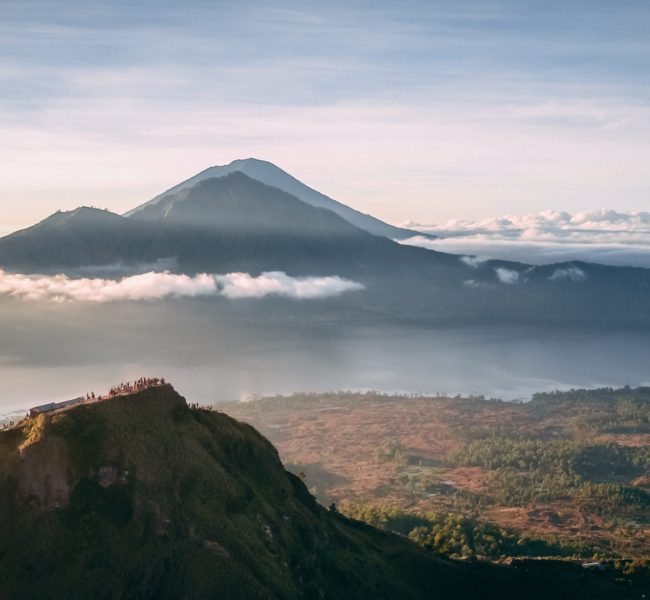
Surf at Balangan beach paradise
The very sight of the half-kilometre stretch of white sands, located in Bukit peninsula at Uluwatu, South Bali, can get you excited. The beach is also known as one of Bali’s best surfing spots due to the magnificent quality of the waves. It is recommended to swim during mid to early high tide as the shallow reefs can make low-tide surfing dangerous. There are many thatch-roof huts and warungs (traditional food stalls) on the eastern side of the coast. Non-surfers can also rent a parasol and soak in the views. The limestone cliffs and the reefs further off the coast offer an excellent vantage point for sunset photography.
Getting there: The coastline of Balangan is located 20 km south of Kuta. If arriving by car, one can park at the edge of the cliffs of Jalan Pantai Balangan, where a nominal fee is charged. As you then follow the dirt track towards the direction of the beach, you’ll come closer to a famous Instagram-able viewpoint overlooking the waters.
Unravelog tip: If you’re into serious surfing, we recommend you visit during the dry months, May to September, when the waves are at their highest.
